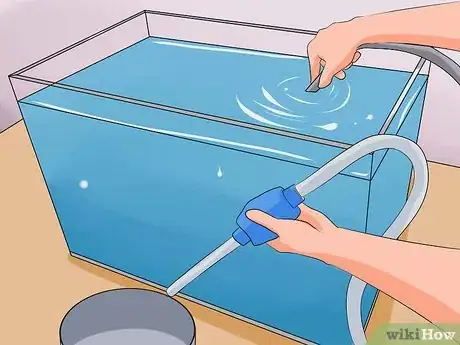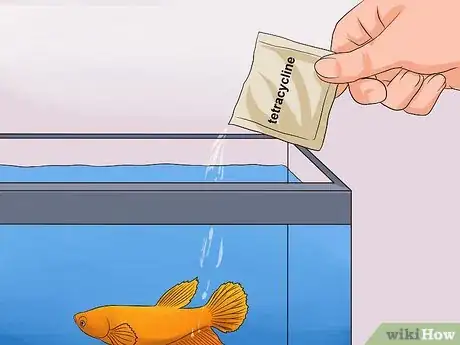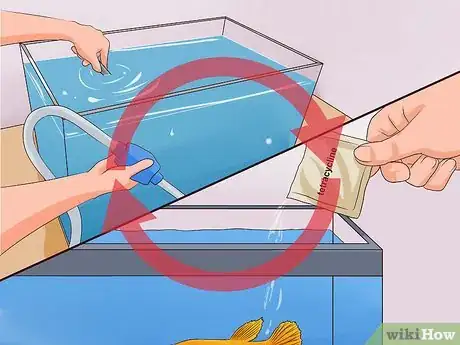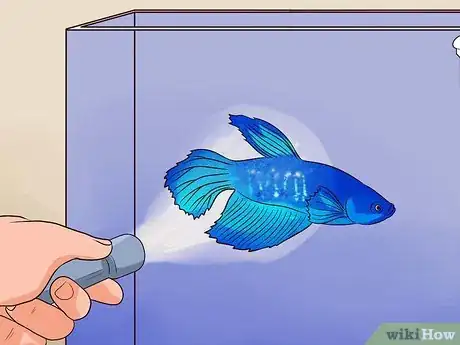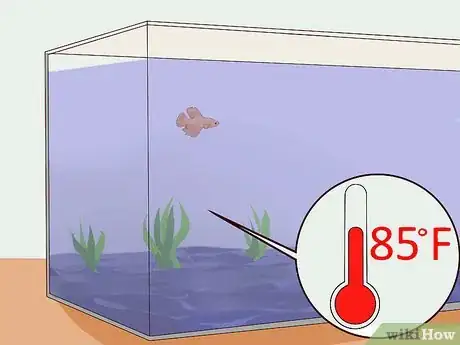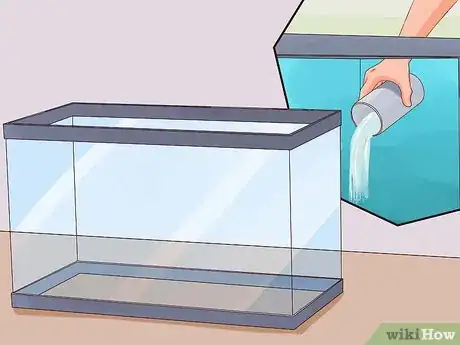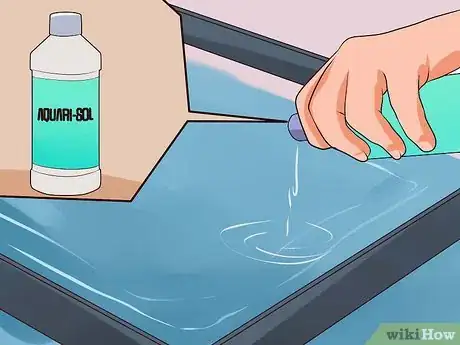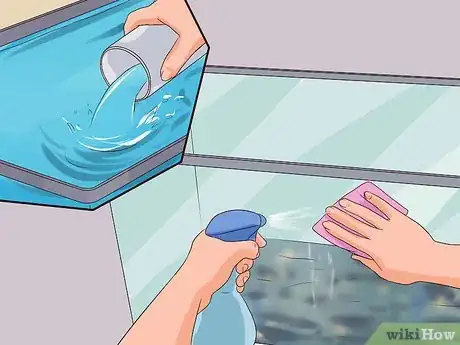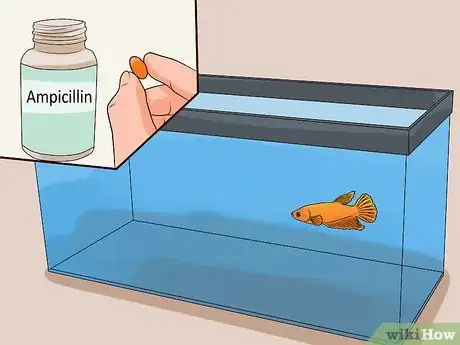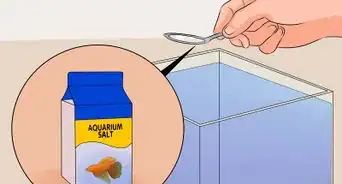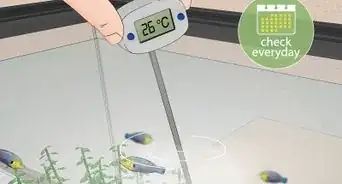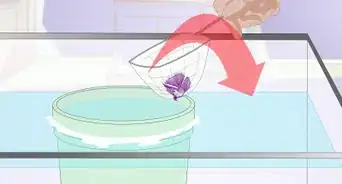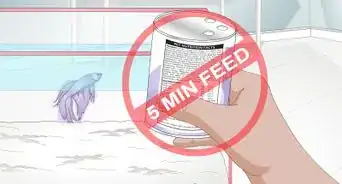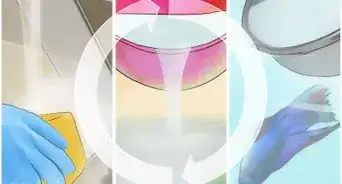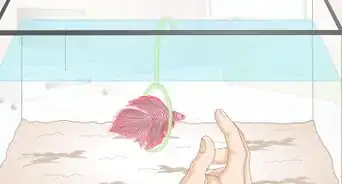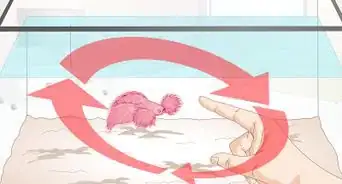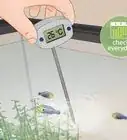This article was co-authored by Craig Morton. Craig Morton is the CEO of Aquarium Doctor Inc. based in Huntington Beach California and servicing Orange County, Los Angeles County, and the Inland Empire. With over 30 years of aquarium experience, Craig specializes in creating custom aquarium designs along with aquarium installation, service, and maintenance.
There are 8 references cited in this article, which can be found at the bottom of the page.
wikiHow marks an article as reader-approved once it receives enough positive feedback. This article received 63 testimonials and 87% of readers who voted found it helpful, earning it our reader-approved status.
This article has been viewed 2,017,248 times.
Bettas exhibit many signs of sickness, from lethargy to white spots. Any time you suspect a betta is sick, you should take it away from other fish, since many illnesses are contagious.[1] Additionally, you may not be able to find medications for bettas in a pet store or even a fish store. If you can't, you can find them online.[2]
Steps
Looking for Signs of an Unhealthy Betta Fish
-
1Watch out for faded coloring. When a betta gets sick, his coloring may look faded out. He may even lose his color altogether.[3]
-
2Keep an eye on your betta's fins. In a healthy betta, its fins will be whole. An unhealthy betta may develop holes or rips in its fins.[4]
- Another unhealthy sign is if your betta's fins appear clamped down to the body; that is, they aren't fanned out properly.[5]
Advertisement -
3Look for lethargy. If your betta is sick, his activity level will go down. He won't be his normal, active self. His movements will slow down some.[6]
- Another sign of sickness is your fish hiding out at the bottom of the tank more often than normal.[7]
- Lethargy can be caused by low or too high temperatures as well, so make sure the temperature range of the water is good.
-
4Watch your betta's eating habits. With some sicknesses, your fish may stop eating altogether. If your betta appears uninterested in food, he could be sick.[8]
-
5
-
6Look for breathing problems. It may sound funny to check a fish for breathing problems. However, if your betta is constantly at the top of the tank trying to get more air, that is likely a sign of a problem.[11]
- Bettas naturally go to the top of the tank to take a breather at times, but doing it frequently is not okay.
-
7Watch for your betta to rub or scratch. If your betta is trying to rub against the side of the tank, that could be a sign of a problem. Similarly, if your betta is trying to scratch on plants or objects in the tank, he might also be sick.[12]
-
8Look for other physical symptoms. Bulging eyes can be a sign of sickness. Watch for your betta's eyes protruding from its head.[13]
Dealing with Constipation
-
1Look for signs of swelling. If your betta fish suddenly swells, he may be constipated. You need to treat this problem soon.[17]
-
2Stop regular food for several days. The first way to help constipation is to stop his regular diet for a few days. That will give him time to digest and move food through his system.[18]
-
3Feed him live food. After a couple of days, start feeding him again. However, you should stick to live food for a little while.[19]
- For live food, you can feed brine shrimp or blood worms. The general rule on how much food to provide is give enough food so that your betta can eat for two minutes. Do so twice a day.[20]
-
4Don't feed him as much. Constipation is generally a sign you are feeding your betta too much. Therefore, once he starts eating normally again, you need to feed him less than you were.[21]
Diagnosing Fin/Tail Rot and Fungal Infections
-
1Look for shredded tails and fins.[22] This disease can affect just the tail or just the fins. However, it gives them a shredded appearance.[23]
- Be aware that some longer-tailed varieties, such as halfmoon bettas, will try to bite their fins because they are too heavy. In this case, look for other symptoms of sickness as well as torn fins.
- Also, look for darker coloring near the end of the tail.
-
2Watch for white patches with fungal infection. This disease is most often noticed by the white patches that appear on your fish. He may also have clumpy fins or be less active than normal. While a fungal infection is different from fin rot, they are treated in much the same way.[24]
-
3Change the water. The first step is to change out the water. Of course, you need to remove your fish to another container while doing so. This disease often develops from dirty water, so you need to provide a clean environment for your fish. You should clean the tank before putting water back in.[25]
- Use a hose to siphon the dirty water out of the tank.[26]
- The best way to clean the tank is to use bleach at a 1 to 20 ratio with water. Let the mixture sit in the tank for about an hour. You can leave the fake plants and scoop in this mixture but not the rocks or gravel, as they can absorb the bleach
- Make sure you rinse it several times after cleaning it.
- For the rocks, bake them at 450 °F (232 °C) for an hour. Let them cool before adding them back in.
-
4Use a medication. You will give your betta tetracycline or ampicillin, which you add to the water. How much you add depends on the size of the tank, but you will find directions on the package.[27]
-
5Repeat the process. Change the water at least every 3 days. Every time you change the water, add the medication back in. Only stop when the betta fins seem to be growing back in, which can take up to a month.[30]
- For fungal infections, look for the white patches and other symptoms to disappear. When they do, treat the tank with Bettazing or Bettamax to help eliminate the fungus.[31]
Dealing with Velvet
-
1Shine a flashlight on your fish. One way to see velvet is to use a light directly on your fish. The light will help you see the shimmer of gold or rust that this disease can produce on the scales. Your fish will exhibit other symptoms, such as lethargy, loss of appetite, and rubbing or scratching himself against walls or items in the aquarium. He may also have clamped fins.
- This parasite can be prevented by adding aquarium salt and water conditioner to your tank on a regular basis.[32] You need to add 1 teaspoon of aquarium salt for 2 1/2 gallons of water. You also need a drop of water conditioner per gallon, though always read the instructions that come with your water conditioner. Only add extra salt when doing water changes, not when topping off a tank. [33]
-
2Use Bettazing. This medication is the most effective against velvet because it has two agents in it that work against the disease. Add 12 drops per gallon of water.[34]
- You can also use a medication called "Maracide".
- Continue treating until the fish no longer exhibits symptoms.
-
3Treat the whole tank. You should still isolate the affected fish, but you should treat the original tank as well. This disease is very contagious.[35]
- To isolate affected fish, you need to move them to a separate tank with clean water. You need to provide treatment to both tanks.
Treating Ich
-
1Look for white spots all over the body that look like salt. Ich is a parasite that produces spots on the body. Also look for clumped fins and lethargy. He may also stop eating.
-
2Try raising the temperature for ich. If you have a large community tank, you can try raising the temperature to 85 degrees Fahrenheit, which will kill off the parasite. However, don't do it if your tank is smaller, as you may mistakenly raise the water too much and kill off your fish.[38]
-
3Change and clean the bowl. With ich, you should change the water. Also, take time to clean out the water, as noted under the section about fin and tail rot and fungal infections. In a smaller tank, you can remove the fish first, clean it, and then heat the water to 85 degrees Fahrenheit before putting the fish back in.[39]
-
4Treat the water. Be sure to put in aquarium salt and water conditioner before returning your fish to the tank. That will keep the tank from reintroducing the parasite to your fish.[40]
-
5
Treating Popeye
-
1Look for bulging eyes. The main symptom of this disease is the fish's eyes protruding from its head. However, sometimes this problem is a symptom of another disease rather than disease itself.[43]
-
2Change and clean the tank. For popeye, you should provide a clean tank, as noted in earlier sections. In addition, change out the water.[46]
-
3Introduce ampicillin. Ampicillin will treat the problem if it's not a symptom of something worse. You need to add this medication every time you change the water and clean the tank, which should happen every 3 days. Continue this regimen for a week after you stop seeing signs of the problem.[47]
Expert Q&A
Did you know you can get expert answers for this article?
Unlock expert answers by supporting wikiHow
-
QuestionWhat medication can I use to treat fin rot?
 Craig MortonCraig Morton is the CEO of Aquarium Doctor Inc. based in Huntington Beach California and servicing Orange County, Los Angeles County, and the Inland Empire. With over 30 years of aquarium experience, Craig specializes in creating custom aquarium designs along with aquarium installation, service, and maintenance.
Craig MortonCraig Morton is the CEO of Aquarium Doctor Inc. based in Huntington Beach California and servicing Orange County, Los Angeles County, and the Inland Empire. With over 30 years of aquarium experience, Craig specializes in creating custom aquarium designs along with aquarium installation, service, and maintenance.
Aquarium Specialist, Aquarium Doctor Inc.
-
QuestionHow often should I change the water in the tank?
 Craig MortonCraig Morton is the CEO of Aquarium Doctor Inc. based in Huntington Beach California and servicing Orange County, Los Angeles County, and the Inland Empire. With over 30 years of aquarium experience, Craig specializes in creating custom aquarium designs along with aquarium installation, service, and maintenance.
Craig MortonCraig Morton is the CEO of Aquarium Doctor Inc. based in Huntington Beach California and servicing Orange County, Los Angeles County, and the Inland Empire. With over 30 years of aquarium experience, Craig specializes in creating custom aquarium designs along with aquarium installation, service, and maintenance.
Aquarium Specialist, Aquarium Doctor Inc.
-
QuestionHow can I keep my betta fish warm?
 Craig MortonCraig Morton is the CEO of Aquarium Doctor Inc. based in Huntington Beach California and servicing Orange County, Los Angeles County, and the Inland Empire. With over 30 years of aquarium experience, Craig specializes in creating custom aquarium designs along with aquarium installation, service, and maintenance.
Craig MortonCraig Morton is the CEO of Aquarium Doctor Inc. based in Huntington Beach California and servicing Orange County, Los Angeles County, and the Inland Empire. With over 30 years of aquarium experience, Craig specializes in creating custom aquarium designs along with aquarium installation, service, and maintenance.
Aquarium Specialist, Aquarium Doctor Inc.
Warnings
- Some "symptoms" aren't actually symptoms. Lethargy can be caused by low temperature (no heater) and rips/tears in fins can be from of nipping or sharp objects. Don't just put in a medication because one of the symptoms for a disease is present! Look for other clues as well.⧼thumbs_response⧽
- Your betta can get other diseases that are not treatable. For instance, dropsy is a fatal disease contracted by bettas. With this disease, your betta's stomach will be bloated, and when you view the betta from the top, you will notice the scales aren't flush with the body. Instead, they will be raised. You cannot treat dropsy; however, you should isolate your fish from other fish if he shows signs of the disease.⧼thumbs_response⧽
- Beware of fish tuberculosis (Mycobacterium marinum). It is contagious, fatal, and can be spread to humans.[48] Symptoms in fish: Lethargy, popeye, deformed skeleton/bent spine. Symptoms in humans: Large cyst-like red lump, usually where the bacteria entered (i.e, open cut). If you think you have fish TB, go to your doctor and specify that you own fish, or your doctor might misdiagnose you.⧼thumbs_response⧽
References
- ↑ http://www.earthsfriends.com/betta-fish-diseases/
- ↑ http://bettatalk.com/betta_diseases.htm
- ↑ http://www.earthsfriends.com/betta-fish-diseases/
- ↑ Craig Morton. Aquarium Specialist, Aquarium Doctor Inc.. Expert Interview. 21 July 2020.
- ↑ http://www.earthsfriends.com/betta-fish-diseases/
- ↑ http://www.petful.com/misc/tips-for-raising-betta-fish/
- ↑ http://www.petful.com/misc/tips-for-raising-betta-fish/
- ↑ http://www.hartz.com/Fish/Getting_Started/caring_for_your_betta_fish.aspx
- ↑ Craig Morton. Aquarium Specialist, Aquarium Doctor Inc.. Expert Interview. 21 July 2020.
- ↑ http://www.earthsfriends.com/betta-fish-diseases/
- ↑ http://www.petful.com/misc/tips-for-raising-betta-fish/
- ↑ http://www.earthsfriends.com/betta-fish-diseases/
- ↑ http://www.earthsfriends.com/betta-fish-diseases/
- ↑ http://www.earthsfriends.com/betta-fish-diseases/
- ↑ http://www.earthsfriends.com/betta-fish-diseases/
- ↑ Craig Morton. Aquarium Specialist, Aquarium Doctor Inc.. Expert Interview. 21 July 2020.
- ↑ http://www.petful.com/misc/tips-for-raising-betta-fish/
- ↑ http://www.petful.com/misc/tips-for-raising-betta-fish/
- ↑ http://www.petful.com/misc/tips-for-raising-betta-fish/
- ↑ http://www.petful.com/misc/tips-for-raising-betta-fish/
- ↑ http://www.petful.com/misc/tips-for-raising-betta-fish/
- ↑ http://www.hartz.com/Fish/Getting_Started/caring_for_your_betta_fish.aspx
- ↑ http://www.earthsfriends.com/betta-fish-diseases/
- ↑ http://bettatalk.com/betta_diseases.htm
- ↑ http://www.earthsfriends.com/betta-fish-diseases/
- ↑ Craig Morton. Aquarium Specialist, Aquarium Doctor Inc.. Expert Interview. 21 July 2020.
- ↑ http://bettatalk.com/betta_diseases.htm
- ↑ http://www.earthsfriends.com/betta-fish-diseases/
- ↑ http://www.earthsfriends.com/betta-fish-diseases/
- ↑ http://bettatalk.com/betta_diseases.htm
- ↑ http://www.earthsfriends.com/betta-fish-diseases/
- ↑ http://www.earthsfriends.com/betta-fish-diseases/
- ↑ http://bettatalk.com/betta_diseases.htm
- ↑ http://bettatalk.com/betta_diseases.htm
- ↑ http://www.earthsfriends.com/betta-fish-diseases/
- ↑ http://www.earthsfriends.com/betta-fish-diseases/
- ↑ http://bettatalk.com/betta_diseases.htm
- ↑ http://www.earthsfriends.com/betta-fish-diseases/
- ↑ http://www.earthsfriends.com/betta-fish-diseases/
- ↑ http://www.earthsfriends.com/betta-fish-diseases/
- ↑ http://bettatalk.com/betta_diseases.htm
- ↑ http://bettatalk.com/betta_diseases.htm
- ↑ http://bettatalk.com/betta_diseases.htm
- ↑ http://bettatalk.com/betta_diseases.htm
- ↑ http://www.earthsfriends.com/betta-fish-diseases/
- ↑ http://www.earthsfriends.com/betta-fish-diseases/
- ↑ http://www.earthsfriends.com/betta-fish-diseases/
- ↑ https://microbewiki.kenyon.edu/index.php/Mycobacteriosis_(Fish_Tuberculosis)
About This Article
To tell if a betta fish is sick, look for signs that it's unhealthy, like faded coloring, torn fins, bulging eyes, white spots, and raised scales. You should also watch out for a decrease in appetite or a low activity level, which are also signs that a betta fish is sick. Also, check your betta fish's stomach to see if it's swollen, which could mean it's constipated. If you think your betta fish is sick, it's important that you take action right away so it gets better. To learn more about treatment methods to help your betta fish feel better, keep reading!

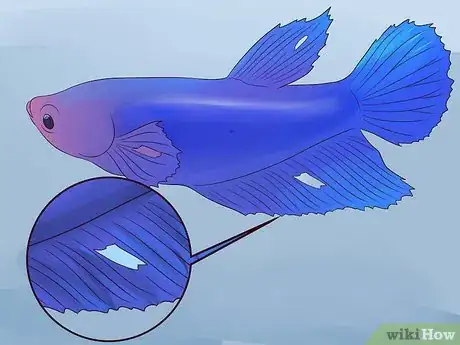


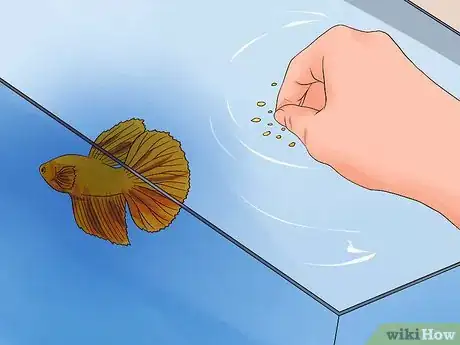


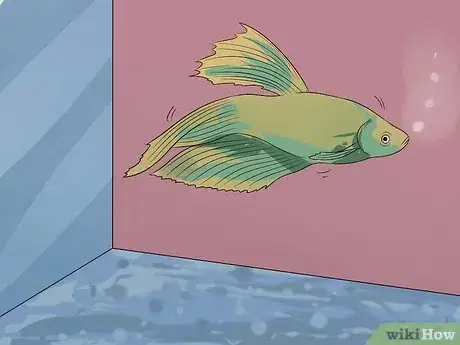
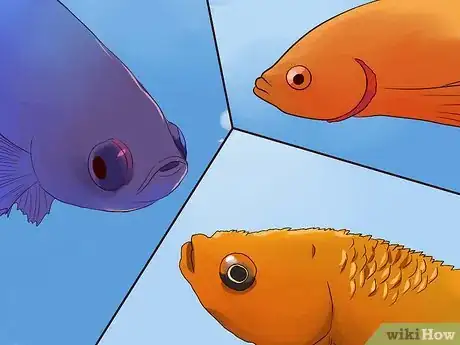
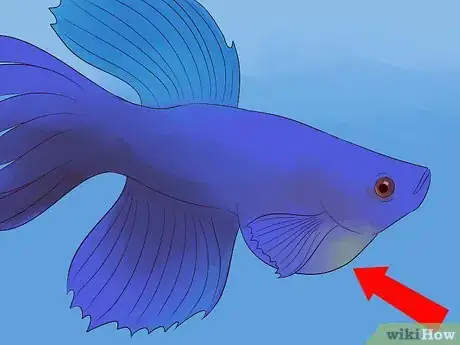
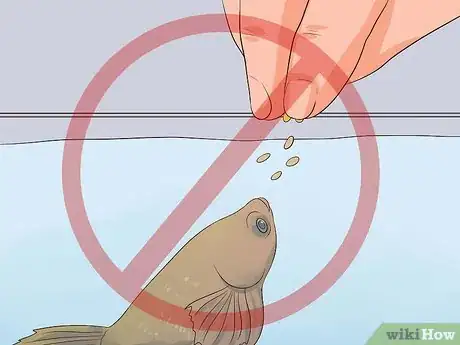

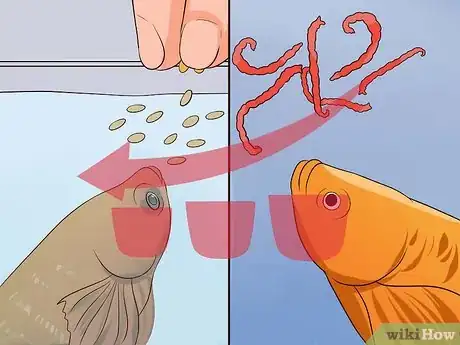
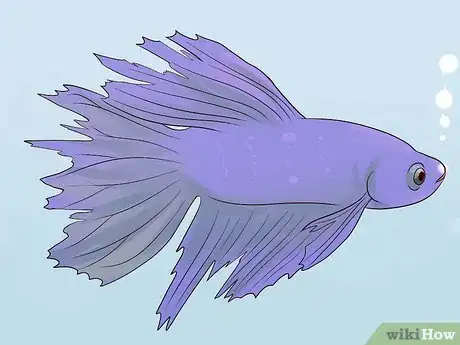
-Step-1-Version-2.webp)
